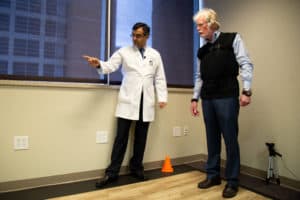Every year in America, health care professionals diagnose 50,000 to 60,000 new cases of Parkinson’s disease. In 2007, Glenn Davis, M.D., was one of those patients, though he’d experienced symptoms a few years prior.
He says he’s slower than he used to be and has to be careful sometimes carrying things. The tremor in his hand has affected his writing. He also had non-motor symptoms like sleep attacks and insomnia.
“I had horrible penmanship already. I’m a physician. But now no one can read my writing anymore. I have to work on that.”
Davis, grandfather of six, enjoys traveling and spending time with his family. The former gastroenterologist is also a vintner with a winery in Napa Valley.
If the mantra in real estate is “Location, Location, Location,” Davis says the mantra for someone living with a chronic illness is “Attitude, Attitude, Attitude.”
“Parkinson’s is a disease. How it affects an individual is an illness,” Davis said. “Each of our illness is different. Our symptoms, treatment responses and prognoses may be different, but we all have the same disease. No one should go through it alone. That’s why it’s important to have good physicians, a support group and resources like the Parkinson’s Foundation that you can access information and learn as much as you can.”
Tuhin Virmani, M.D., Ph.D., is a movement disorder neurologist who sees patients in the UAMS Jackson T. Stephens Spine & Neurosciences Institute. Because there are both motor and non-motor symptoms for Parkinson’s, Virmani says it’s important to treat the whole patient. That’s one of the reasons Davis chose UAMS.
“The non-motor symptoms of the disease are just as important as the motor symptoms,” Virmani said. “You have to be able to take care of all aspects of a patient to treat them to the fullest.”
As a researcher, Virmani has been particularly interested in studying a debilitating symptom in Parkinson’s patients called freezing of gait. Patients feel like their feet are stuck to the ground. Some patients develop the symptom soon after diagnosis, while others experience it after the disease has progressed.
Virmani offers his patients the option to visit the lab after clinical visits and typically sees them every three to six months.
“If we can see the transition, it allows us to better predict when a patient may develop freezing of gait,” Virmani said. “That will allow us to develop other treatment strategies that may stop freezing of gait from developing.”
Virmani and other neurologists work closely with the Parkinson’s Foundation. It’s a relationship, Virmani says, that helps pool resources in promoting awareness and a sense of community and support.
“Patients need to surround themselves with a good support group. Get to know others with Parkinson’s disease,” Davis said.
In April, there are opportunities to meet others living with Parkinson’s disease and interact with experts as they discuss the latest advancements in treatment. UAMS’ Annual Parkinson’s Symposium is scheduled for Apr. 7 from 1 p.m. to 5 p.m. The Parkinson’s Foundation hosts walks around the country. Moving Day Little Rock is scheduled for Apr. 27.


